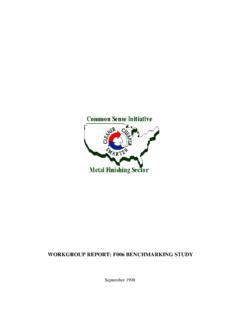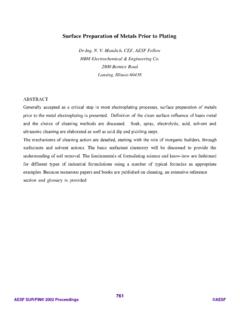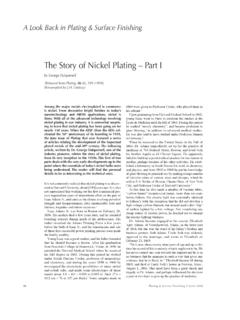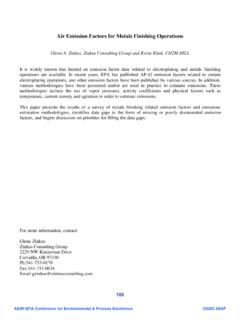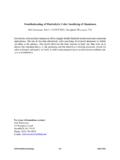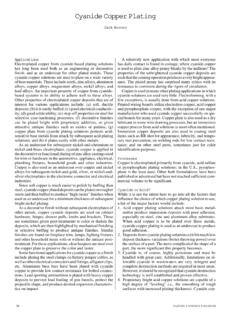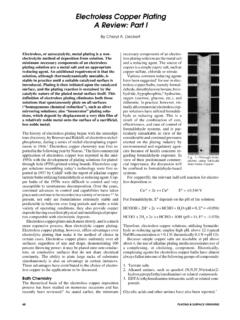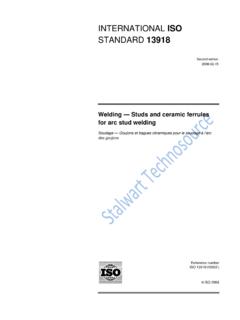Transcription of The Protection of Silver Against Atmospheric Attack
1 Technical Article The Protection of Silver Against Atmospheric Attack by P-A. Gay,* P. Ber ot & J. Pagetti Tarnishing of Silver and its alloys in certain environ- Oils ments is a persistent problem. This paper explains Various oils or waxes can be dissolved in perchlorethyl- the various measures used to date to retard Silver ene, familiar as a common dry cleaning solvent. Objects tarnishing in various applications, such as jewelry, to be covered are dipped into the solution and successively the silversmith trade and electronics. Different anti- removed. After the perchlorethylene evaporates, the pro- tarnish methods have been proposed by the scien- tective coating remains on the surface and protects the tific community, none of which perfectly satisfy the object from tarnishing. By a simple water or soap rinse, requirements of all applications. A method of incor- these oil films can be completely eliminated.
2 This method porating fine organic and/or inorganic particles into is suitable for protecting details in storage. However, Silver -based electrolytic coatings is a very promising because of the low thickness of the film, any handling of solution. However promising, we find it still needs the treated objects should be avoided. further development. The tarnish film appearing on Silver surfaces limits the Inorganic Deposits application of Silver -containing alloys in many fields. At the moment, inorganic or metal coatings deposited by Tarnishing is very harmful in electronic applications CVD/PVD, electrochemically or by immersion are most because of the added electrical resistance. In decorative frequently used to prevent Silver tarnishing. These meth- applications, it ruins the workpiece appearance (color and ods can be classed into the following primary areas. brightness).
3 In addition, the weldability of Silver deterio- rates. Chromate Conversion Coatings Nowadays existing processes will retard the natural Chromate conversion coating processes involve immer- Silver conversion but cannot completely eliminate sion of an object in a solution containing chromic acid, Any solution to the tarnish problem has to be a com- chromates and/or dichromates as primary ingredients. For promise between three fundamental aspects: (1) surface example, the film obtained from a potassium dichromate appearance, (2) contact resistance and (3) weldability. bath insures ideal surface Protection Against tarnishing. There are several methods to protect Silver Against tar- Much work has been done in this area. Lacourcelle, et nishing. The most frequently used technique consists of described a bath containing: depositing a protective film (organic, mineral or metal) on the Silver object.
4 Some protective methods are still under Potassium dichromate (K2Cr2O7) 20 g/L ( oz/gal). development while the others have already found wide- Potassium hydroxide (KOH) 20 g/L ( oz/gal). spread industrial application. They can be grouped into Potassium carbonate (K2CO3) 40 g/L ( oz/gal). various categories. The solution concentration, temperature, pH and treatment Organic Deposits time should be taken into account to avoid the appearance Lacquers of an undesirable colored film that is detrimental to the final appearance. The use of lacquers poses some problems for the surface Randin, et studied the electrochemical chromate appearance of the product. Indeed, a protective lacquer conversion process as an anti-tarnish treatment on a variety film degrades slowly over time and eventually alters the surface appearance, usually negatively. This film becomes yellow and can ultimately disappear after several months.
5 Some films can be hardened with a thermal treatment and provide longer life. However, complete Protection cannot Nuts & Bolts: be achieved with lacquers. What This Paper Means to You *. Work in nanotechnology is opening up new avenues in our Corresponding Author: industry, but meanwhile, Silver still tarnishes. This age-old prob- Dr. Pierre-Antoine Gay Ecole d'Ingenieurs du Canton de Neuch tel-EICN lem affects areas ranging from electronics to jewelry. Here, the Dept. de Microtechnique authors have surveyed the work that has been done and is ongo- 7, Av. de l'Hotel-de-Ville ing, to give us a tour de force of the means of preventing, if not CH-2400 Le Locle Switzerland eliminating the tarnishing of Silver . E-mail: Pl a t i n g & S u r face Fin ish in g May 2 0 0 4 71. 0332~ 71 4/30/04, 8:52:04 AM. of substrates (In, Au, Ag and Cu) used in ornamental applications.
6 ( to 3 wt%) and/or Cd, Sn, Ga and/or Zn ( to wt%). The influence of the composition of the bath as well as that of other These alloys can be used for decorative applications, but they operating parameters was studied. The tarnish resistance of the need to be annealed between 220 and 900 C (428 and 1652 F). chromate conversion coatings was investigated, in particular, after for 30 min. Finally, Silver alloys containing about 6 wt% In, a weak abrasive treatment. The chromate conversion coating did wt% Al and 3 wt% Cu show improved results in tarnishing tests not alter the surface appearance of any of the substrate materials in aqueous solution containing 5% NaCl or Na2S. However, studied and provided very effective Protection Against tarnishing. a Silver alloy of similar composition (7 wt% In, wt% Al and 4. It could be cleaned in the isopropanol with no loss in tarnish resis- wt% Cu) degrades rather quickly after immersion in Na2S.
7 Tance. However, it did not withstand the abrasive effect of polish- aqueous solution for 10 hr. This example illustrates the complexity ing to the degree generally employed by jewelers. Chromating of Silver tarnishing chemistry, and in particular the importance of remains one of the most effective solutions for the Protection of the chemical composition of the Silver -based alloy which can best Silver workpieces Against tarnishing. However, the use of hexava- retard tarnishing. lent chromium chemistry in the jewelry and silversmith trades is Electrolytic composite coatings have been studied with an eye strongly prohibited because of its high toxicity. toward tarnish resistance. For this purpose, De Bonte, et stud- ied the incorporation of fine germanium oxide (GeO2) particles in Oxides electrolytic deposition processes. Silver alloy coatings containing up to 6 wt% germanium were electrodeposited from a cyanide Many studies reported in the literature deal with the possibility of solution without brighteners.
8 Codeposition of germanium with depositing a highly insulating film on Silver objects ( , oxides Silver improves tarnish resistance in the thioacetamide test (ISO. of the III-V elements). Price and Thomas9 proposed an effective 4538) when compared to pure Silver . The coating surface became way to avoid tarnishing. This process involved an anodization in yellowish instead of darkening, and the corrosion products could an acidic solution (pH = ) at approximately A/dm2 ( A/. be easily removed by simple water rinsing. ft2). The results of tarnishing tests were better than those obtained Similar results were obtained for Silver -germanium and Silver - with chromate conversion coatings. A German patent10 describes copper-germanium alloys studied by In two cases, it oxide deposition by sputtering. Substrates were preheated between appears that the formation of Ag2S layers was inhibited by a pro- 100 and 200 C (212 and 392 F).
9 Hard coatings of silica or alumina tective effect caused by GeOx species. were deposited by sputtering at a pressure between and 10 Pa Incorporation of fine PTFE particles by electrolysis was studied ( 10-5 and 10-3 lb/in2). The layer thickness was between to improve the tarnish resistance of Silver and its alloys by Gay2. and 10 m ( to 394 -in) [preferentially between and 2. and In some cases, Silver coatings with PTFE contents up m ( and -in)]. to 25 vol% were found to be good candidates to block the forma- tion of Ag2S. Tin (Sn) The use of rhodium, palladium and platinum coatings for Silver Among other chemical processes it is important to note the tin tarnish Protection is strongly suggested for luxury jewelry chloride solution ,11 Tin is used to protect Silver objects The use of zinc and the cadmium, on the other hand, does not show because its color and hue are very similar to those of Silver .
10 Three promising As for mercury, its use is prohibited because of methods of tin coating are usually cited. its high toxicity. Tin tempering. Objects to be protected are immersed in a bath containing 9 to 23% metal fluoborate solution (the metal being less Organic Inhibitors noble than Silver , such as Cr, Pb, Ni, Co, Cd, In, Zn or Sn). After a visible film appears, usually in about 5 sec, the parts are removed Lohmeyer, et proposed inhibitors based on long-chain aliphatic from solution. This method is described in a thiocyanates as giving suitable Protection . Inhibitors dissolved in Degreasing Tinning. Pieces to be coated are immersed in an an organic solvent are deposited on the surface of the object. The alkaline hydroxide bath containing to 10% of a bivalent organic deposited layers had no significant effect on the electrical contact or inorganic tin compound.
